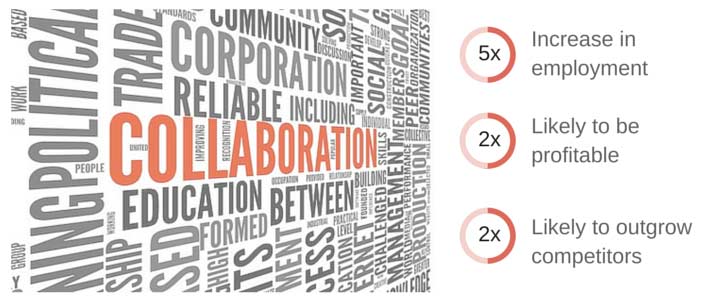Modern technologies have allowed company intranets to evolve and move past being the clunky, outdated systems which merely allowed employees to share information. Today’s intranets, coupled with faster internet speeds, have allowed for new ways of working in which colleagues can more effectively collaborate with others. The importance of collaboration in today's workplace is now very well documented. It's clear that collaboration provides businesses with a diverse range of benefits, including reduced costs. So move out of messy email threads to social intranet tools that will start taking workplace collaboration to the next level.

Online collaboration via the company intranet is optimised by the creation of social elements and shared workspaces. Collaboration at work can take place between departments, with offices located in the other parts of the world, and even with remote workers.
This allows for information to flow more freely around an organisation and for departments which may have once rarely interacted to better communicate and work on projects together.
Improving collaboration in the workplace leads to:
- Reduced costs
- Improved interdepartmental relationships and working practices
- Improved relationships with customers and suppliers
- Employees feeling more valued
- Transparency within the organisation
In fact, according to Deloitte research, companies that prioritise collaboration are:
- 5x more likely to experience a considerable increase in employment
- 2x as likely to be profitable
- 2x as likely to outgrow competitors

How Do You Improve Collaboration in the Workplace? Social tools are vital for successful workplace collaboration.
According to McKinsey, “by fully implementing social technologies, companies have an opportunity to raise the productivity of interaction workers – high-skill knowledge workers, including managers and professionals – by 20 to 25 percent.” The report goes on to say that the value to business lies in the use of social tools, which can enhance communications across the board, as well as improve knowledge sharing and collaboration. These tools are at the heart of the successful intranet, as they allow for less time spent on searching for email and performing job-specific tasks. This is because “messages become content” and therefore essentially become searchable knowledge.
Without a collaboration platform, this wouldn’t be possible and organisations could find that as much as 35% of employee time is wasted searching for information which using the intranet they could very easily find.
Why Choose an Intranet over Standalone Collaboration Software?
A quick search on Google will reveal several platforms aimed at improving collaboration in the workplace. You may choose a standalone platform that focuses solely on enterprise collaboration tools. However, choosing an intranet solution offers benefits that shouldn't be overlooked. Intranets also provide additional functionality for creating effective digital workplaces. Why? Because it helps with knowledge management, from easy management of content and documents. It can also improve processes from issue tracking management, to alert notifications and advanced and automated forms and workflows.
For example, intranet collaboration software offers sophisticated workflow engines to provide both serial and parallel workflow processes. Workflows allow the organization to save a lot of time on chasing up paper forms. Users can see at a glance if forms have been completed or are being processed. For the user, workflows and forms are presented in such a way that it’s simple to check the status of forms and what actions need to be applied next.
For example, routing rules that are implemented can define whether the workflow needs to be skipped, reassigned, ended or passed to another user. Workflows can also be approved or rejected via email and modules added that allow a manager to approve or reject forms.When action is required from another user, notifications can easily be set up to alert them. All of this is fully trackable and each and every form that’s processed can be kept for auditing and a full history.
Ultimately, choosing the best online collaboration tools for your organisation's needs, will offer a range of other benefits that extend beyond communication.
Achieving the Social Intranet
To reap the full benefit of the intranet and avoid common intranet mistakes, an organisation should consider incorporating social tools to boost employee collaboration. Intranet social tools are key and capable of transforming company culture and business processes. McKinsey points out that modern organisations will also have to foster a healthy culture and “transform their structures [and] processes.” Organisations that want to make the most out of collaborative practices must become more open, less hierarchical and ensure that a sense of trust is created and maintained. The intranet itself helps to do this so long as it’s well designed enough to engage users.
This in itself is not an easy feat, so it’s necessary for the intranet designers to plan the project carefully, preferably getting employees involved at every stage in order to gain useful feedback on the following:
By getting workers involved in the setting up of the intranet, it’s likely that they will later become advocates of the intranet and encourage others to use it to its full potential. It’s also useful to incorporate employees who enjoy blogging, writing and graphic design in the content creation stage of developing your intranet platform. This in itself creates intranet use cases where the design and deployment of the intranet itself becomes a collaborative project that’s viable for success.
All in the Design
Intranets that have existed within an organisation for many years often become disjointed as new sections are created and added to the infrastructure. This creates a situation where content becomes fragmented and difficult to find. This means that it’s highly desirable for companies to regularly takes stock and monitor how the intranet is performing at regular intervals. Intranet analytics can be used to discover how much time is being wasted looking for information by employees which in turn translates into a dip in productivity.
“According to IDC, ineffective information access costs organisations an annual productivity hit of up to $14,000 per employee. An intranet analytics audit would focus on identifying and refining failed search queries to save employee time and boost productivity. Refining 10 failed search queries, for example, equates to saving around 15 minutes of employee time.”
Lack of Employee Engagement Costs
So whilst the intranet itself boosts productivity through improved communication and collaboration, it must contain the right social collaboration tools in order to ensure that it fulfils its purpose. Some, if not all, of these tools should be social in nature as these will boost engagement with the intranet and enable effective employee collaboration. It’s thought that engaged employees lead to higher earnings per share for organisations, with disengaged workers thought to cost companies somewhere in the region of $450bn to $550bn each year in the US.
A well-designed intranet can become the foundation of your employee engagement platform with the tools to boost engagement and will therefore save an organisation a lot in terms of revenue through improved productivity. Research has found that engaged users and a collaborative workplace culture also ensures that users are empowered and therefore engaged also with the goals of the organisation. According to The Grossman Group, communication and engagement barriers cause productivity losses of $24.217 per employee each year.
With this in mind, it’s important to understand that the power of today’s intranet and the internet must be harnessed if the benefits of collaborative practices are to be maximised upon. An intranet is the hub from which everything is pulled together to give workers effective tools that can help them by collaborating effectively with colleagues within the organisation.
